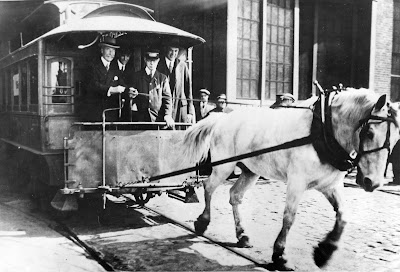During this week in the year 1887, the Schenectady Street Railway Company first began offering trolley services to the public. The company started its service with 30 horses, 5 trolley cars, and 4 sleighs. The single track route for the trolley line ran about 2 miles, from the Schenectady side of the Scotia bridge at the foot of Washington Avenue, up State Street, and ending at the company's stables, car barn, and office at Brandywine Avenue and State Street. The trolley service opened on July 16, 1887, and began with a dedication at Crescent Park. The inaugural trolley was painted a bright red and yellow, and was pulled by a pair of white horses. Fourth ward alderman J. Ezra McCue was said to be the first man to board the trolley in Schenectady and pay the 5-cent fare, ushering in the era of trolley transportation that would continue in Schenectady through the mid-1940s.
 |
| A horse-drawn trolley travels along State Street, ca. 1890. Photograph from Grems-Doolittle Library Photograph Collection. |
The trolleys were an improvement over the stagecoach -- horses could haul more people more easily over rails than they could over cobblestone or rutted roads. Like in any new venture, unforeseen problems did crop up. One initial problem was that the horses were not used to pulling a trolley car; some pulled the cars off of the track and onto the cobblestone streets. This was quickly resolved as both horses and drivers became accustomed to the vehicles. Another concern was how to manage crossing the railroad tracks on State Street; the tracks had not yet been elevated and were at street level. The city government first ordered that the trolley stop at the tracks, all passengers exit and cross the tracks on foot, then board a second trolley waiting on the other side. Public protest soon quashed this measure, and the wave of the flagman then allowed streetcars to cross.
 |
| A lone horse works hard to pull a trolley car along in this early photo. Photograph from Larry Hart Collection. |
Horsecars came late to Schenectady, having been used in other American cities since the 1830s. By the mid-1880s, there were over 400 trolley companies in operation nationwide. By the time horse-drawn streetcar service came to Schenectady, the Edison Machine Works (later the General Electric Company) had already been established, and the city was standing on the threshold of its rapid development as the "Electric City." Larry Hart, in a 1960 Schenectady Union-Star column, noted that "the horsecar was doomed to early replacement here by an offspring of the wonder of the age -- electricity." After only four short years, the route was electrified and electric trolley service began on July 2, 1891. Being at least twice as fast as the horse-drawn trolleys, the electric trolley helped the city to expand in the coming years. By 1927, the Schenectady Railway Company operated 140 miles of track, employed over 500 people, owned over 200 cars -- certainly a far cry from the streetcar's beginnings in Schenectady 40 years before.



No comments:
Post a Comment